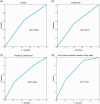Chinese men living in urban areas of Shijiazhuang, Hebei at higher risk of overweight or obesity
- PMID: 32809884
- PMCID: PMC7436783
- DOI: 10.1177/0300060520945885
Chinese men living in urban areas of Shijiazhuang, Hebei at higher risk of overweight or obesity
Abstract
Objective: The prevalence of overweight/obesity in China has increased dramatically in recent years; being overweight/obese can increase the risk of type 2 diabetes and cardiovascular disease. The purpose of this study was to determine the population in China at high risk of being overweight or obese, to explore the relationships between various relevant factors and overweight/obesity, and to identify preventive efforts for high-risk populations.
Methods: We administered a questionnaire survey among a group of 536 social workers in Shijiazhuang City in 2017. We used the Pearson chi-square test, Spearman's rho test, multivariate linear regression, univariate and multivariate logistic regression, and receiver operating characteristic curve analysis to investigate factors that influence overweight/obesity.
Results: The prevalence of overweight/obesity was 13.7% among the study participants. Urban residence, eating speed, number of daily meals, overeating, and a high-fat diet were associated with overweight/obesity. In multivariate linear regression analysis, overweight/obesity was correlated with sex, urban residence, eating speed, number of daily meals, and a high-fat diet.
Conclusion: Among all influencing factors, dietary factors, place of residence, and sex were most closely related to being overweight/obese. Furthermore, living in an urban area and male sex were independent risk factors for being overweight/obese.
Keywords: China; Overweight; men; obesity; risk factor; urban.
Figures

References
-
- Bhardwaj S, Misra A, Khurana L, et al. Childhood obesity in Asian Indians: a burgeoning cause of insulin resistance, diabetes and sub-clinical inflammation. Asia Pac J Clin Nutr 2008; 17: 172–175. - PubMed
-
- World Health Organization (WHO). Obesity and overweight. 2018. https://www.who.int/news-room/fact-sheets/detail/obesity-and-overweight (accessed 16 February 2018).
-
- Morrison JA, Barton BA, Biro FM, et al. Overweight, fat patterning, and cardiovascular disease risk factors in black and white boys. J Pediatr 1999; 135: 451–457. - PubMed
-
- Harris MM, Stevens J, Thomas N, et al. Associations of fat distribution and obesity with hypertension in a bi-ethnic population: the ARIC study. Atherosclerosis Risk in Communities Study. Obes Res 2000; 8: 516–524. - PubMed
MeSH terms
LinkOut - more resources
Full Text Sources
Medical

